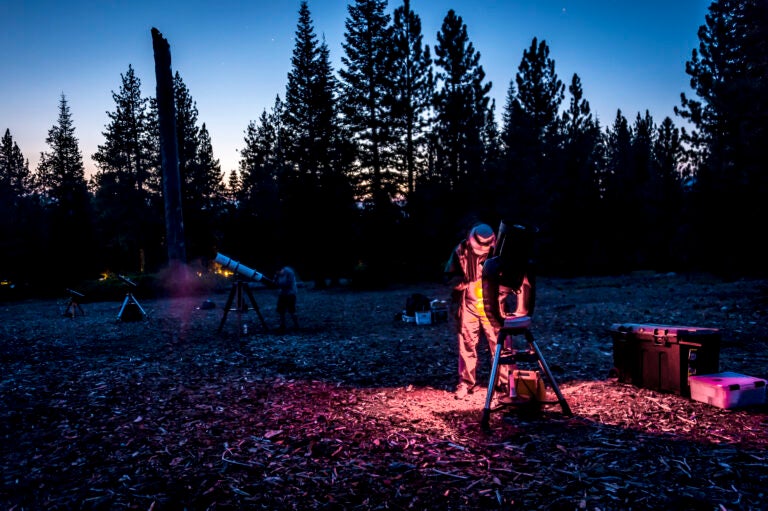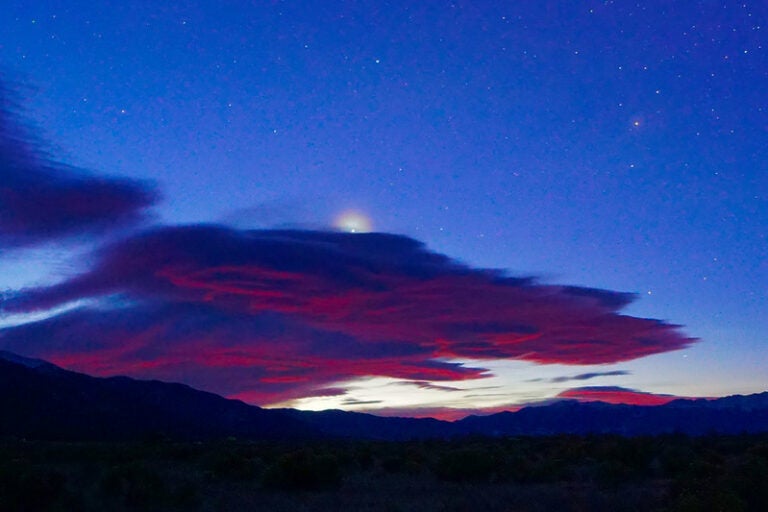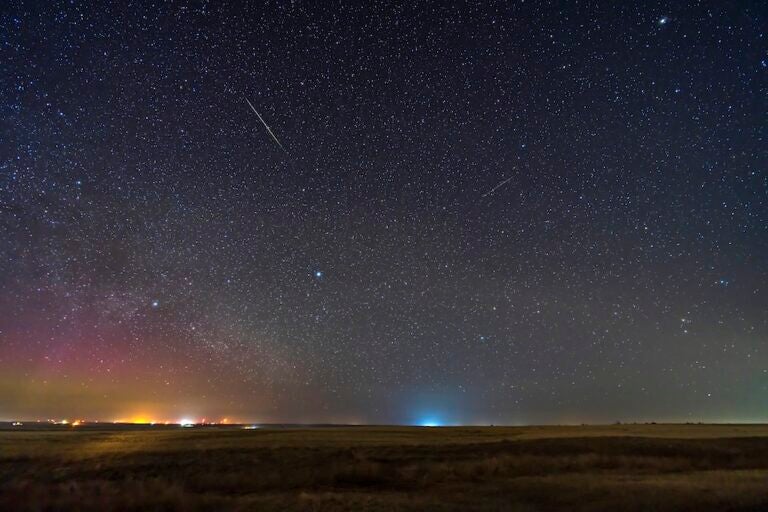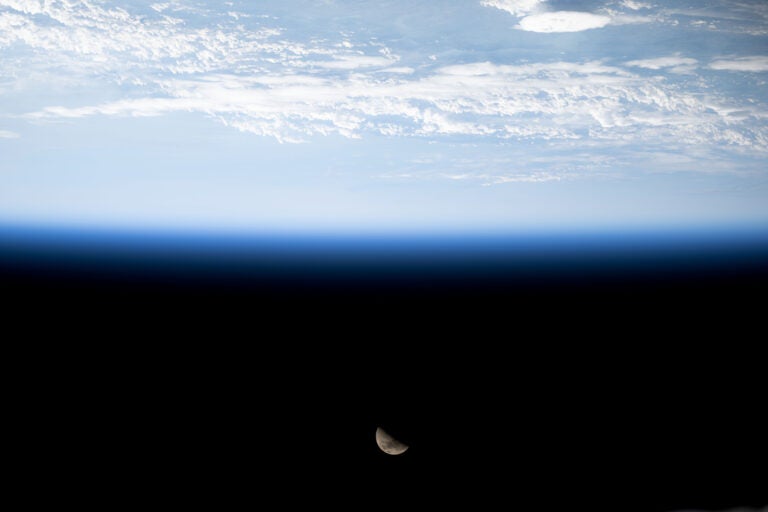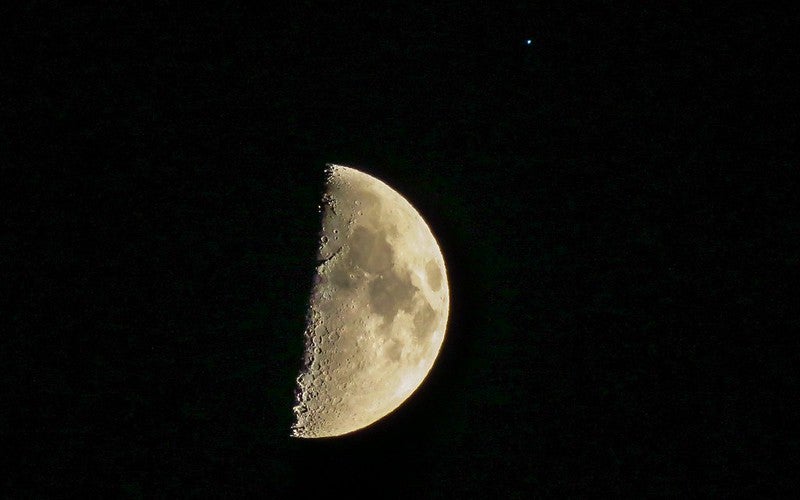
Friday, July 12
The Moon reaches apogee, the farthest point from Earth in its orbit, at 4:11 A.M. EDT. At that time, Luna will sit 251,259 miles (404,362 kilometers) away.
Look east a few hours after sunset and you’ll find the cross-shaped constellation Cygnus the Swan already high above the horizon and still climbing. The longer “beam” of the cross is anchored at the northeastern end by Cygnus’ alpha star, Deneb, which also marks the tail of the Swan. At the southwestern end lies the Swan’s beta star, Albireo, at the bird’s head or beak.
Just where the crossbeams meet (where the Swan’s wings extend from its body) is magnitude 2.2 Sadr (Gamma [γ] Cygni). It lies to the upper right of Deneb as Cygnus is rising in the sky tonight. Just 0.5° north of Sadr, easily within the field of view of either a telescope or binoculars, is the magnitude 7.5 open cluster NGC 6910.
Spanning about 8′, this smattering of some 70 young stars forms a rough Y shape and sits in the midst of IC 1318, a swath of hydrogen gas and dust sometimes called the Gamma Cygni Nebula because of its proximity to the star. The cluster and nebula both lie within the richly appointed star-forming region known as the Cygnus OB9 Association.
Sunrise: 5:42 A.M.
Sunset: 8:29 P.M.
Moonrise: 12:13 P.M.
Moonset: —
Moon Phase: Waxing crescent (38%)
*Times for sunrise, sunset, moonrise, and moonset are given in local time from 40° N 90° W. The Moon’s illumination is given at 12 P.M. local time from the same location.
Saturday, July 13
Early risers this morning can catch Jupiter as it sits some 5° north of Aldebaran, the bright red eye of Taurus the Bull. Wait until about 4 A.M. local daylight time, when the V-shaped constellation has largely cleared the eastern horizon. At that time, Jupiter stands about 12° high and to the upper left of Aldebaran, just below the planet. Jupiter blazes at magnitude –2.1, outshining the red giant star, which is magnitude 0.9.
First Quarter Moon occurs at 6:49 P.M. EDT, with our satellite now in the constellation Virgo. Later this evening, the Moon passes 0.9° due north of the Maiden’s alpha star, magnitude 1 Spica, at 11 P.M. EDT — and depending on your location you may see the Moon pass in front of the star in an occultation visible across North and Central America.
The timing of the event is, as always, heavily location dependent. On the East Coast, it’s visible shortly before moonset, with the Moon covering Spica starting at 11:25 P.M. EDT from Newark, New Jersey, and at 10:10 P.M. CDT from Chicago. Because of Luna’s motion, the still-darkened western half will move over the star first, offering an interesting sight.
Spica reappears from behind the Moon roughly an hour and a half to an hour and 45 minutes later — again, the duration will depend significantly on your location. You can check the timing near you on the International Occultation Timing Association’s webpage for the event. Note that all times listed are in UTC on July 14 (early morning on the 14th in UTC is still late evening on the 13th in North America) and will need to be converted to local time.
Sunrise: 5:43 A.M.
Sunset: 8:28 A.M.
Moonrise: 1:13 P.M.
Moonset: 12:03 A.M.
Moon Phase: Waxing crescent (48%)
Sunday, July 14
Mercury is growing fainter in the evening sky but remains above the horizon for about 80 minutes after sunset. Located in far western Leo the Lion, the tiny planet is now magnitude 0.2 and some 3° high an hour after sunset, as the sky is growing dark. You’ll find it to the lower right of magnitude 1.4 Regulus, the heart of the Lion, which stands about three times as high above the western horizon at the same time. Through a telescope, Mercury appears 57 percent lit, with a disk spanning 7″.
To the upper right of Leo, closer to the North Celestial Pole, stands Ursa Major the Great Bear. This constellation contains one of the sky’s most famous asterisms: the Big Dipper. The star at the very end of the Dipper’s handle is magnitude 1.2 Alkaid. The next star along the handle, 2nd-magnitude Mizar, has a close companion, 4th-magnitude Alcor, just under 12′ (1/5°) away. Keen-eyed observers will likely be able to see both stars unaided once the sky grows dark enough. If you’re having trouble, though, the two are easily split by any optics, including both binoculars and telescopes.
Mizar itself became the first-known double star, consisting of two suns some 14″ apart. Its duality was discovered in 1650 by Italian astronomer G. B. Riccioli. These two stars are an easy pair to split in a telescope, offering a great target for beginning observers, according to the late stellar expert Jim Kaler.
Sunrise: 5:44 A.M.
Sunset: 8:28 P.M.
Moonrise: 2:14 P.M.
Moonset: 12:23 A.M.
Moon Phase: Waxing gibbous (57%)
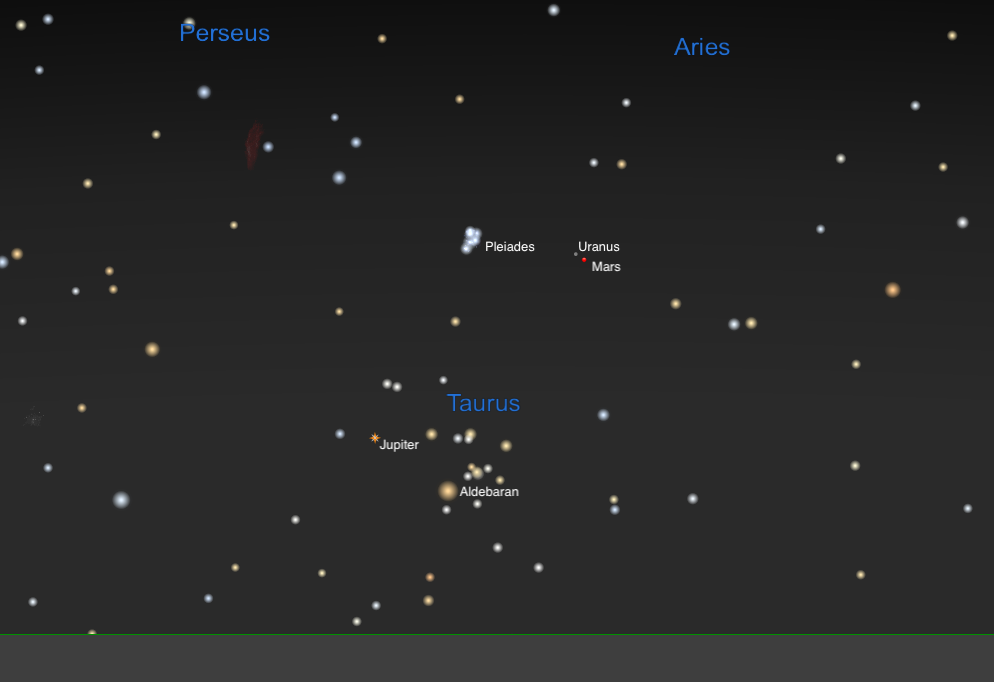
Monday, July 15
Mars passes 0.6° south of Uranus at 5 A.M. EDT in a close conjunction that brings the outer and inner solar system together.
Visible in the few hours before sunrise, the pair is already 20° high around 3:45 A.M. local daylight time. They stand in the east in Taurus the Bull, to the upper right of bright Jupiter and just to the lower right of the famous Pleiades star cluster (M45).
Mars, at magnitude 0.9, is readily visible to the naked eye. Its partner Uranus, though, is magnitude 5.8 — just barely visible to naked-eye observers under ideal conditions and better seen with the aid of optics. So, simply swing up binoculars or any size telescope toward Mars, and your field of view will include distant Uranus directly to the Red Planet’s north.
The contrast between them is striking: Mars appears not as a fully lit disk but a gibbous some 90 percent illuminated. Its disk spans 6″ on the sky. Uranus, meanwhile, may be difficult to discern from the background stars — look for a “flatter,” blue-gray-colored star that appears more disklike than pointlike — that’s Uranus, which spans half of Mars’ width at 3″.
Consider, however, that in truth Mars is a rocky world about half the size of Earth and some one-tenth is mass; Uranus is an ice giant spanning four times Earth’s width and with 14.5 times its heft.
Sunrise: 5:45 A.M.
Sunset: 8:27 P.M.
Moonrise: 3:18 P.M.
Moonset: 12:46 A.M.
Moon Phase: Waxing gibbous (67%)
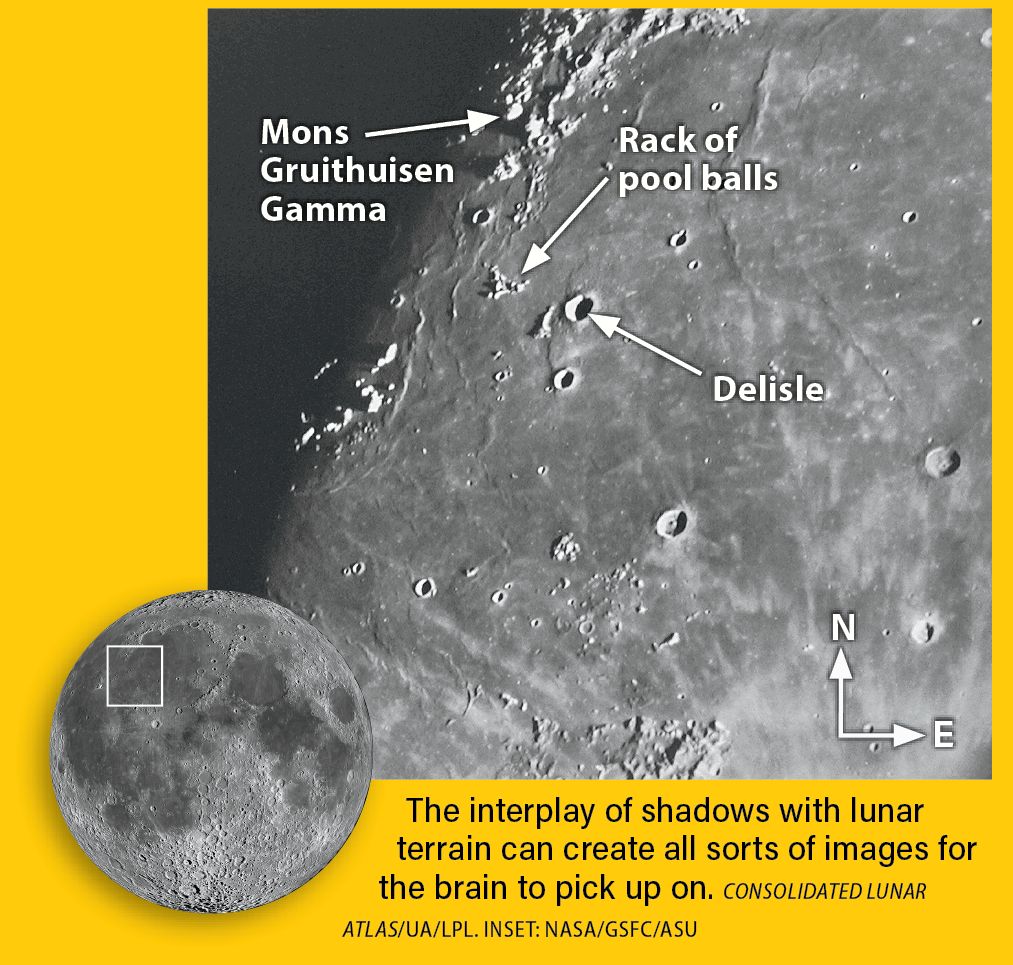
Tuesday, July 16
By the time the Sun sets, the waxing gibbous Moon is high in the south, approaching the pincers of Scorpius the Scorpion. Tomorrow, our satellite will pass close to the arachnid’s heart, but tonight Luna sits to the right of the red giant star.
Home in on the lunar northwest with your telescope to catch sunrise over the western rim of the Sea of Rains (Mare Imbrium). Use the map above to locate the small crater Delisle, which spans some 16 miles (25 km) and sits north of the slightly smaller crater Diophantus and northeast of the 19-mile-long (30 km) mountain ridge Mons Delisle.
Now, look just northwest of these craters. Do you see a shape that looks like a triangular rack of pool balls, just waiting for the break? This structure is in actuality a series of peaks left over after the huge impact that created Mare Imbrium; once lava welled up from below, the mountaintops were all that remained visible.
RELATED: 20 things to see on the Moon
Nearby, north of our pool balls, stands Mons Gruithuisen Gamma, a large lunar dome along Mare Imbrium’s edge. At this lunar phase, the region around the dome often reminds observers of an upturned bathtub or sink basin — what do you think?
Sunrise: 5:45 A.M.
Sunset: 8:27 P.M.
Moonrise: 4:24 P.M.
Moonset: 1:13 A.M.
Moon Phase: Waxing gibbous (76%)
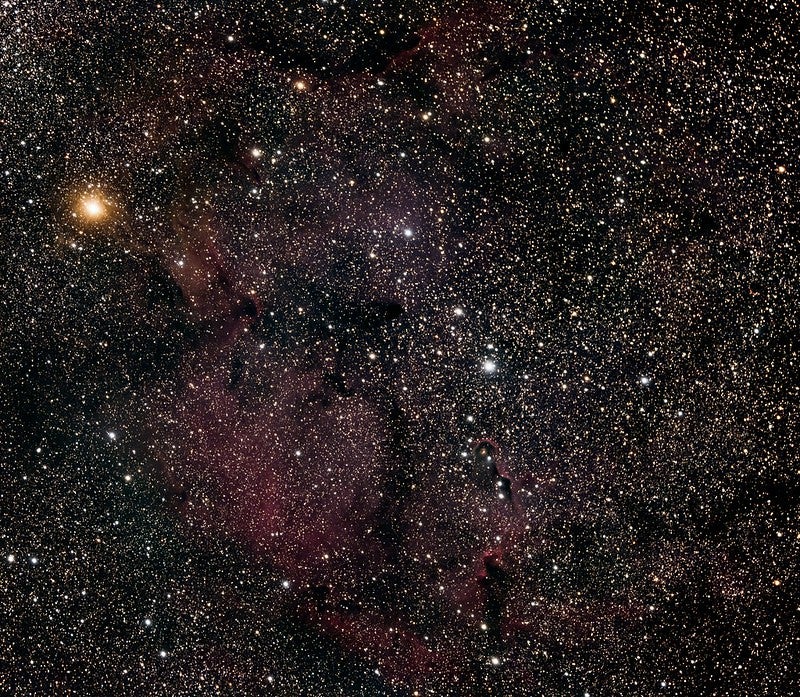
Wednesday, July 17
The Moon passes 0.2° north of Antares at 4 P.M. EDT this afternoon; by evening, our satellite floats to the lower left of the bright star, above the curving tail of the Scorpion and to the right of the Teapot in Sagittarius.
Because the waxing gibbous Moon is so bright, let’s try to catch a little darkness on the other side of the sky. Turn and face north, where the W of Cassiopeia is now facing upright in the sky. Above Cassiopeia, the house-shaped constellation Cepheus is slowly rotating upside-down to stand on the star that marks the point of its “roof.”
Cepheus houses the Herschel’s Garnet Star, which is also cataloged as Mu (μ) Cephei. This 4th-magnitude gem lies on the opposite side of the constellation from its roof, just below the rough midpoint on a line connecting the two stars at the house’s base (Alpha [α] and Zeta [ζ] Cep). It lies about 5° southeast of Alpha Cep and will show up nicely in binoculars or any small scope.
Mu Cep is a ruby-red star that is also a variable; its brightness swings between magnitudes 3.4 and 5.1. The cycle lasts almost exactly two years (though the period itself is variable as well) and you’re in luck — it is currently at its brightest, shining around magnitude 3.4.
The Garnet Star’s eponymous color comes from its temperature — like Antares in Scorpius, Mu Cep is a cool red supergiant star.
Sunrise: 5:46 A.M.
Sunset: 8:26 P.M.
Moonrise: 5:31 P.M.
Moonset: 1:46 A.M.
Moon Phase: Waxing gibbous (84%)
Thursday, July 18
Asteroid 2 Pallas stands stationary against the background stars of Serpens at 5 P.M. EDT. For those wanting to spot the second-known asteroid in the main belt, you can find it high in the south after sunset, beneath the upturned U shape of Corona Borealis.
Pallas is now magnitude 9.8, requiring optical magnification to identify. A small or medium scope should do it; look about 3.7° south of magnitude 4.6 Delta (δ) Coronae Borealis, which lies in the eastern portion of the Northern Crown’s curve. Pallas is currently some 2.62 astronomical units from Earth — 1 astronomical unit, or AU, is the average Earth-Sun distance, which puts Pallas roughly 243.5 million miles (392 million km) away.
Previously moving westward, or retrograde, against the background stars, Pallas will now begin to make a slow swing eastward toward Hercules, which it will enter in mid-August.
Sunrise: 5:47 A.M.
Sunset: 8:25 P.M.
Moonrise: 6:37 P.M.
Moonset: 2:27 A.M.
Moon Phase: Waxing gibbous (91%)
Friday, July 19
Saturn’s two-faced moon Iapetus is now brightening as it moves toward western elongation later in the month. One side of Iapetus is dark and the other is light; at its eastern elongation, that dark side faces us, dimming the moon to around 12th magnitude. At western elongation, the brighter side is turned earthward, so the moon shines nearly two magnitudes brighter.
Around 4 A.M. local daylight time, Saturn stands high in the south in the constellation Aquarius. At magnitude 0.8, it’s brighter than the Water-bearer’s stars, making it easy to identify. Zoom in on the ringed planet with a telescope and you’ll spot its brightest moon, 8th-magnitude Titan, almost 3′ to Saturn’s west. But Iapetus now lies a little over twice that, some 7.5′ west of the planet, nearing 10th magnitude. By the morning of the 27th, the date Iapetus reaches its western elongation, the moon will stand more than 9′ from the planet.
This morning you might also spot the 10th-magnitude moons Tethys, Rhea, and Dione, similarly lining up with their brethren on either side of Saturn. Tethys and Rhea lie east of Saturn, with the former closer to the planet. Dione is west of the planet, about one-third of the way from the tip of the rings to Titan’s position.
Sunrise: 5:48 A.M.
Sunset: 8:25 P.M.
Moonrise: 7:37 P.M.
Moonset: 3:21 A.M.
Moon Phase: Waxing gibbous (96%)

Sky This Week is brought to you in part by Celestron.


